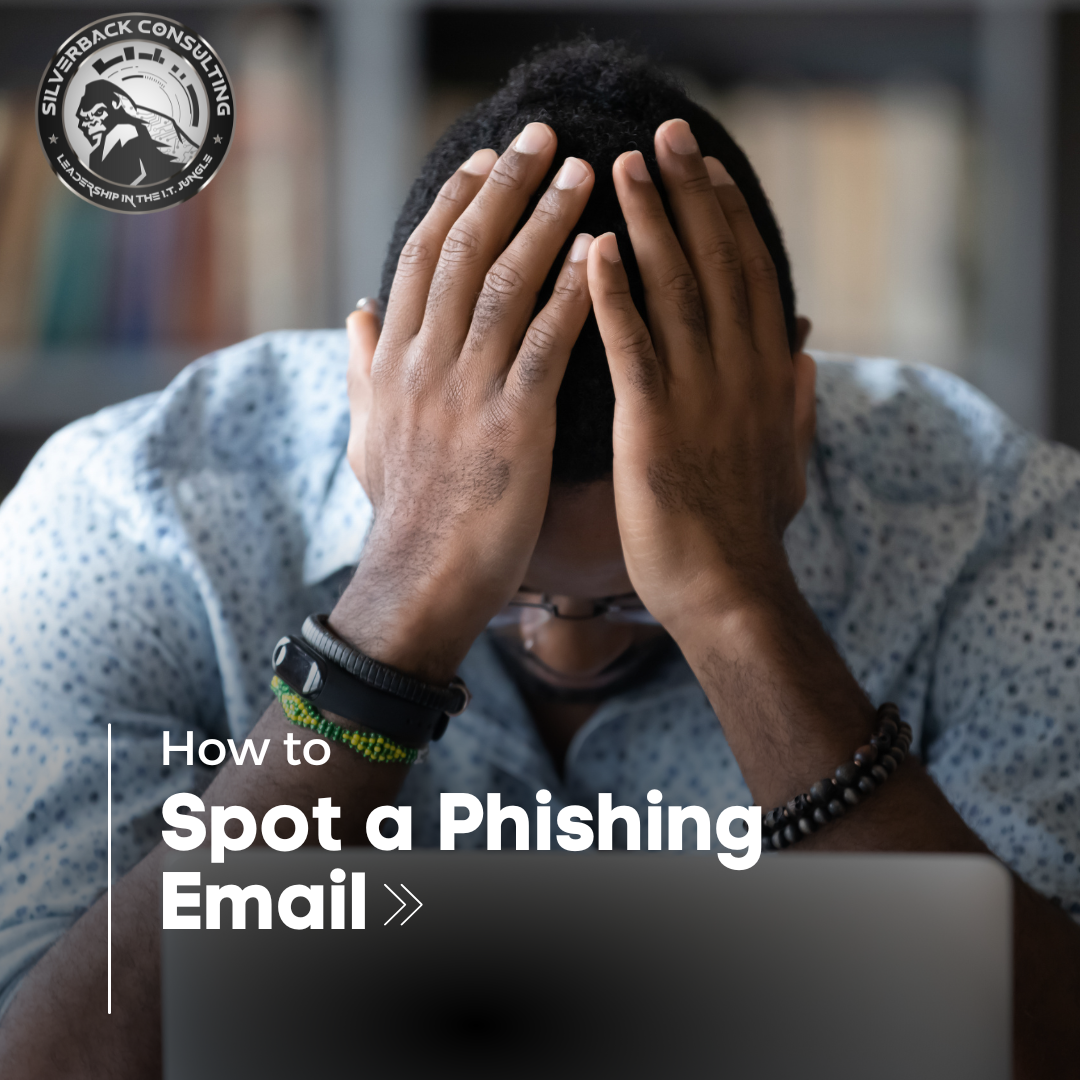Introduction
How to spot a phishing email is a critical skill every business should prioritize. Phishing attacks remain one of the most common and damaging cybersecurity threats organizations face.
At Silverback Consulting, we help businesses stay protected by emphasizing the importance of awareness and prevention.
In this article, we’ll break down the key signs of a phishing email, share real-world examples, and offer practical steps to improve your phishing protection strategy.
2 Why Businesses Must Be Concerned
Phishing doesn’t just target individuals, it’s a serious threat to businesses.
One successful phishing attack can lead to:
-
- Data breaches
-
- Ransomware infections
-
- Financial loss
-
- Regulatory fines
-
- Damaged brand reputation
With phishing protection for businesses becoming a top priority, understanding and spotting phishing emails is your first line of defense.
3 Top Signs of a Phishing Email

1. Unfamiliar or Misspelled Email Addresses
Cybercriminals often use email addresses that look similar to legitimate ones, with slight misspellings or extra characters. For example, support@paypall.com instead of support@paypal.com.
2. Urgent or Threatening Language
Phishing emails often create a sense of urgency. Phrases like “Your account will be suspended!” or “Immediate action required!” are designed to pressure you into acting quickly without thinking.
3. Unexpected Attachments or Links
If an email contains attachments or hyperlinks you weren’t expecting, especially from unknown senders—proceed with extreme caution. These can lead to malware or phishing sites.
4. Generic Greetings
Legitimate businesses usually personalize their emails. Phishing attempts often begin with generic salutations like “Dear Customer” instead of your actual name.
5. Suspicious URLs
Hovering over links in the email can reveal where they actually lead. If the URL doesn’t match the supposed sender or looks suspicious, do not click.
6. Inconsistent Branding or Grammar Errors
Professional companies maintain high standards in communication. Poor grammar, typos, or odd formatting are strong indicators that the email may be fake.
4 Real Examples of Phishing Emails

Example 1: Fake Invoice from a Vendor
Subject: “Invoice #4823 – Payment Required Immediately”
From: invoice@vend0r-payments.com
Body: “Please find attached your invoice. Failure to pay within 24 hours will result in penalties.”
Red flags:
- Misspelled domain (vend0r with a zero)
- Urgent language
- Unrequested attachment
- No contact information
Example 2: Security Alert from “Microsoft”
Subject: “Suspicious Login Attempt Detected”
From: security@m1crosoft-support.com
Body: “Click here to secure your account: [malicious-link.com]”
Red flags:
- Domain impersonation
- Fear-inducing message
- Malicious link disguised as a security action
5 Steps to Take When You Suspect a Phishing Email
Knowing how to spot a phishing email is only half the battle. The next step is taking action:
- Do Not Click Links or Download Attachments.
Avoid interacting with anything in the email until it’s verified. - Verify the Sender.
Contact the individual or organization directly using trusted contact information. - Report the Email to Your IT Team.
Your IT or cybersecurity team should assess the threat and potentially block the sender. - Use Built-In Email Security Tools.
Many platforms offer “Report Phishing” buttons. Use them to help improve threat detection. - Educate Your Team Regularly.
Phishing tactics evolve, and ongoing training helps ensure your team stays ahead.
6 Phishing Protection for Business: Best Practices

1. Security Awareness Training
Regular training ensures employees recognize the signs of a phishing email. Incorporate simulated phishing campaigns to test readiness.
2. Email Filtering and Security Gateways
Advanced filters can detect suspicious emails before they reach your inbox.
Use tools with AI-based threat detection.
3. Multi-Factor Authentication (MFA)
Even if credentials are stolen, MFA adds a vital security layer to prevent unauthorized access.
4. Endpoint Protection
Deploy antivirus and endpoint detection and response (EDR) solutions across all business devices.
5. Regular Software Updates
Outdated software can be an open door for cybercriminals. Patch vulnerabilities promptly.
7 How Silverback Consulting Helps You Stay Protected
At Silverback Consulting, we specialize in comprehensive cybersecurity solutions tailored to the unique needs of your business. Our services include:
- Employee phishing awareness training
- Managed detection and response
- Threat intelligence services
- Email security solutions
- Incident response planning
We go beyond detection—we prevent phishing attacks before they cause harm.
Whether you’re a small business or a growing enterprise, our cybersecurity experts ensure you’re not left vulnerable.
8 Conclusion
Knowing how to spot a phishing email can make the difference between a secure business and a devastating data breach.
By recognizing the common signs of a phishing email, educating your team, and implementing layered security strategies, your organization can stay one step ahead of cybercriminals.
9 What is a phishing attack?
A phishing attack is a form of online fraud where cybercriminals pose as trusted entities to deceive recipients into sharing confidential information or clicking harmful links. These schemes are typically carried out via deceptive emails.
10 How can I recognize a suspicious email?
Warning signs include unfamiliar sender addresses, urgent or threatening language, poor grammar, unexpected attachments, and links that lead to questionable websites. If anything feels off, it’s best to verify before taking action.
11 Why are these attacks a major risk for businesses?
A single successful scam can lead to stolen credentials, data breaches, financial loss, and reputational damage. That’s why employee training and preventative security measures are essential for organizations of all sizes.
12 What steps should I take if I receive a suspicious message?
Avoid clicking any links or downloading attachments. Report the message to your IT or security team immediately, and delete the email. Using a “Report” feature in your email client can also help flag similar threats in the future.
13 Can scam emails slip past filters?
Yes. Even advanced spam filters can miss highly targeted or well-crafted scams. This makes user vigilance and layered security tools critical to effective protection.
14 How does Silverback Consulting support businesses with email security?
We offer a range of tailored cybersecurity solutions, including staff training, email threat detection, and proactive monitoring. Our goal is to keep your team informed and your systems secure against evolving digital threats.
Ready to Strengthen Your Phishing Protection?
Cybercriminals are constantly evolving. Are you prepared?
Whether you’re a small business or a growing enterprise, the risk of falling victim to a targeted email scam is real and costly. We at Silverback Consulting provide proactive, customized cybersecurity solutions that help you detect, prevent and respond to email-based threats before damage is done.
Let’s talk about how we can protect your people and data.
Contact Us Today
Fill out the form below and a cybersecurity expert from our team will reach out to you with a customized consultation.
Silverback Consulting
303 South Santa Fe Ave
Pueblo, CO 81003
719-452-2205
support@silverbackconsulting.us
“Leadership in the I.T. Jungle”





